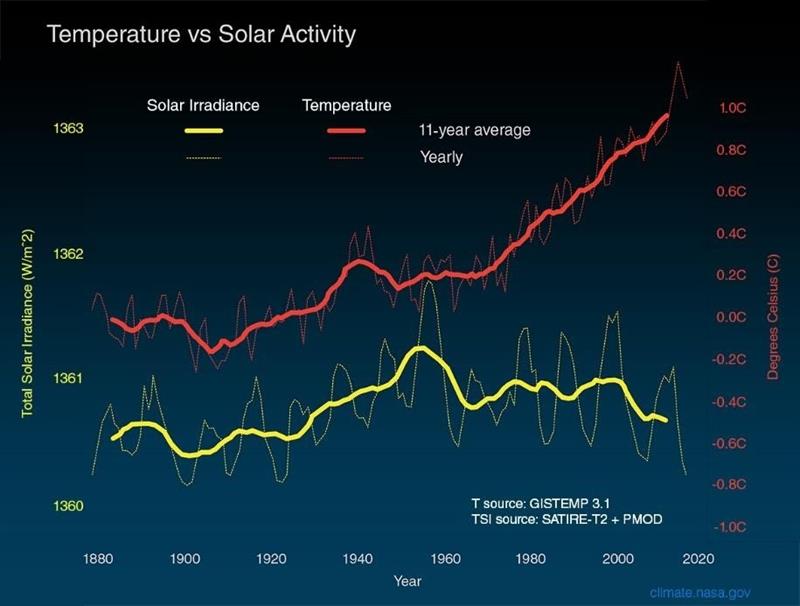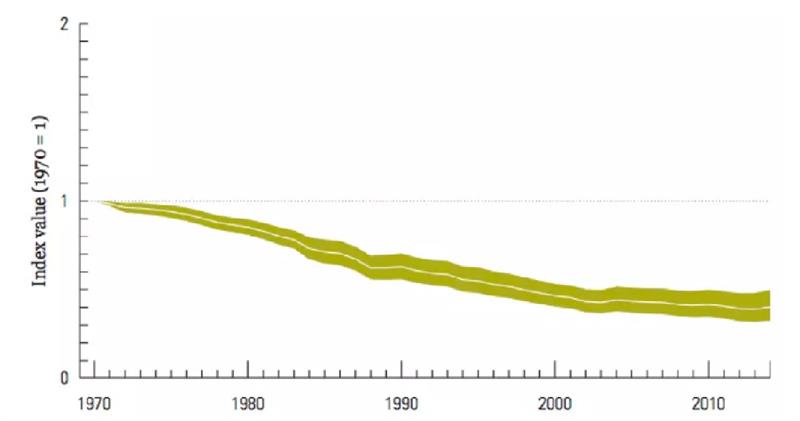In its Fifth Assessment Report, the UN’s Intergovernmental Panel on Climate Change, concluded that it is more than 95% probable that the rise in the earth’s temperature over the last 50 years (Figure 1, below), has been caused by human activities.
Fortunately, our society is becoming increasingly aware of the impact of our activities and more and more government policies are concerned with the protection of endangered species, reduction of carbon emissions, sustainability and pollution of all types.

Businesses too are increasingly aware of their impact on the environment, responding with an increased focus on carbon emissions, which have become relatively easy to measure.
There is a growing concern, however, that the obsession with carbon emissions has distracted attention from the equally important issues related to biodiversity, the variety of the planet’s natural ecosystems and species. Biodiversity protection and climate change are inextricably linked, and the management and protection of biodiversity is necessary to mitigate the negative impacts of climate change and help humans adapt to it. Biodiversity is, however being lost at an unprecedented rate, with a recent World Wildlife Fund, (WWF), report estimating a 60 percent fall in the populations of mammals, birds, fish, reptiles and amphibians in just over 40 years.
Although business is becoming more aware of this growing issue, a recent survey of the top Fortune 100 companies found that very few companies could quantify the biodiversity commitments they were making. This lack of SMART objectives is more a reflection of the difficulties in measuring the impact of activities on biodiversity than an indication of a lack of intent on behalf of industry.

WWF’s Living Planet Index (Source: WWF: Living Planet Report 2018)
The IoT brings Hope
There are however good reasons for optimism as we enter the Industry 4.0 era. High profile use cases such as robotics and autonomous automobiles, may gain the most media coverage but there are a growing number of examples where sensor technologies, networks, software and IT companies are coming together to address the problems involved in monitoring and quantifying the impact of business on biodiversity. IoT sensors are becoming smaller and cheaper and creative power management techniques enable many to operate for extended periods of time on battery power or harvested energy.
In parallel Low-Power Long Range, (LPWA), communications protocols and the falling costs of satellite communications are enabling these sensors to communicate economically over longer distances. This ability to cheaply deploy IoT networks is creating new opportunities for the monitoring and protection of endangered species and their environment. Remote sensor networks are being deployed in many of the world’s designated protected areas, such as Africa’s national parks, to monitor animal movements and distress levels, alerting rangers to poaching activity.
The shrinking size and costs of IoT sensors are also behind a growing range of applications which aim to reduce the impact of agriculture on the environment. It is now economically feasible, for example, for farmers to blanket entire fields with sensors to measure soil temperature and moisture, enabling more effective use of groundwater.
In California, IBM is working with a range of local partners to implement a system to monitor groundwater usage in the Sacramento-San Joaquin River Delta, a major contributor to the state’s water system. The delta provides habitat for dozens of legally protected fish, plant and animal species but, with 75% of the land area also being used for agriculture, this key aquifer is under threat. The partnership is installing remote IoT sensors to measure groundwater usage in real time and transmit the data via satellite to the IBM blockchain platform, hosted in the IBM Cloud. The blockchain platform is then used to manage an innovative system enabling local stakeholders and regulators to manage and trade water access rights.
At sea, Vessel Management Systems, (VMS), based on a combination of ship-based sensors, GPS receivers and satellite communications, are helping governments monitor and reduce Illegal, Unreported and Unregulated, (IUU), fishing activities. Indonesia recently reported a 90% drop in illegal fishing vessels over the last 5 years, with an associated increase in fish stocks. The government’s proprietary VMS was used to enforce a 2014 ban on illegal fishing and the system enabled the exclusion of around 10,000 foreign vessels from Indonesian waters as well as the seizure and destruction of more than 500 illegal vessels.
Conclusion
Although our industrial history may suggest a negative correlation between economic growth and the health of the planet’s biodiversity, the explosive growth of the IoT brings hope for the sustainability of future industrial practices. A growing trend is emerging for business and industry to collaborate with governments, non-profit organizations and research establishments to create innovative applications designed to monitor and protect the environment. The economic feasibility of these solutions is being driven by the falling costs and reduced power consumption of IoT sensors along with advances in networking technologies.
Beekeeping Case study
When discussing the threat to our planet’s biodiversity it is impossible not to highlight the importance of the honeybee. One in every three bites of food eaten globally depend on this and other pollinators and the economic impact of their work, in terms of food sales, can be measured in billions of dollars. The numbers of these important pollinator however are on the decline, particularly in the United States and Europe, where various studies report an average 33 percent annual population loss. Of equal concern is that, although experts attribute the loss to a variety of factors, including pesticides, habitat loss, and disease, there is no single, easily addressable cause.
Three years ago, Broodminder, a US start-up was founded by Rich Morris, electronics engineer and keen beekeeper, with the goal of using IoT technology to monitor the health of this key species. Temperature and humidity are key indicators of hive health and Broodminder have created a portfolio of low-cost temperature and humidity sensing systems, based on smart Blue-tooth low-power devices, manufactured by Silicon Labs.
The company’s first product was a combined temperature and humidity sensor, based on Silicon Labs BLE113 device and this was followed by a hive scale and then a low-cost temperature sensor, based on the Blue Gecko BGM11S SiP Bluetooth module. These devices enable beekeepers to remotely monitor the health of their hives without the need to open them, potentially exposing the bees to adverse conditions and interrupting the honey production process.
Broodminder have also launched a dedicated communications hub, based on the Silicon Labs Bluegiga BLE121 module, enabling beekeepers to share their hive data in the public domain. The creation of this dataset, generated in true citizen-science fashion, will enable the future application of AI technology to shed light on the factors affecting bee populations and, potentially, help to improve hive outcomes.
Author details: Ross Sabolcik is VP and General Manager Industrial and Commercial IoT Products at Silicon Labs













